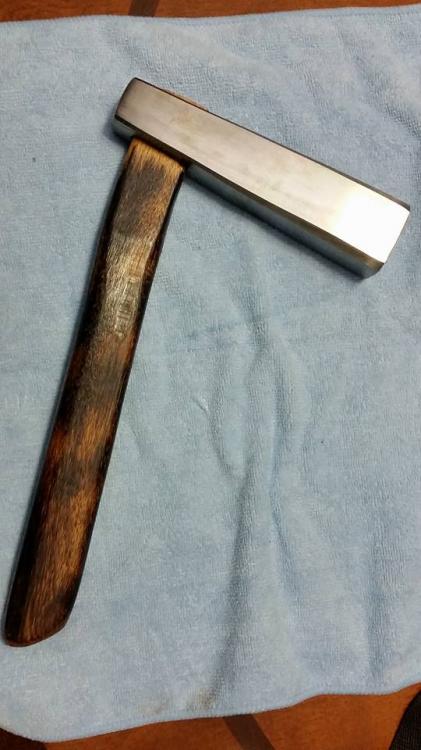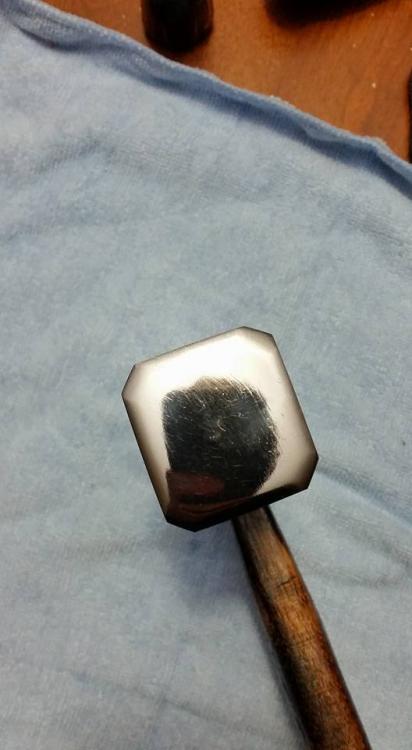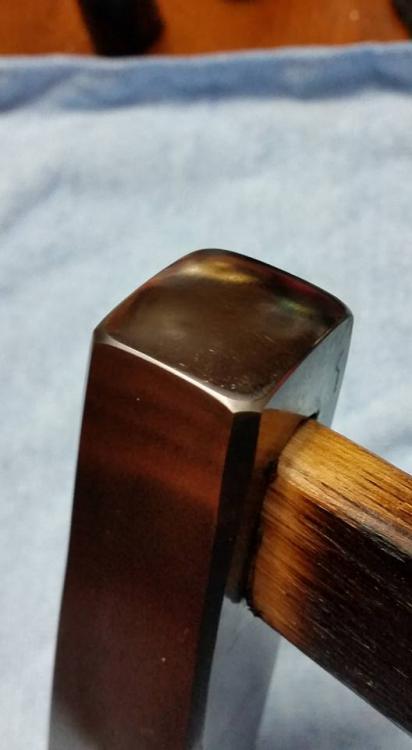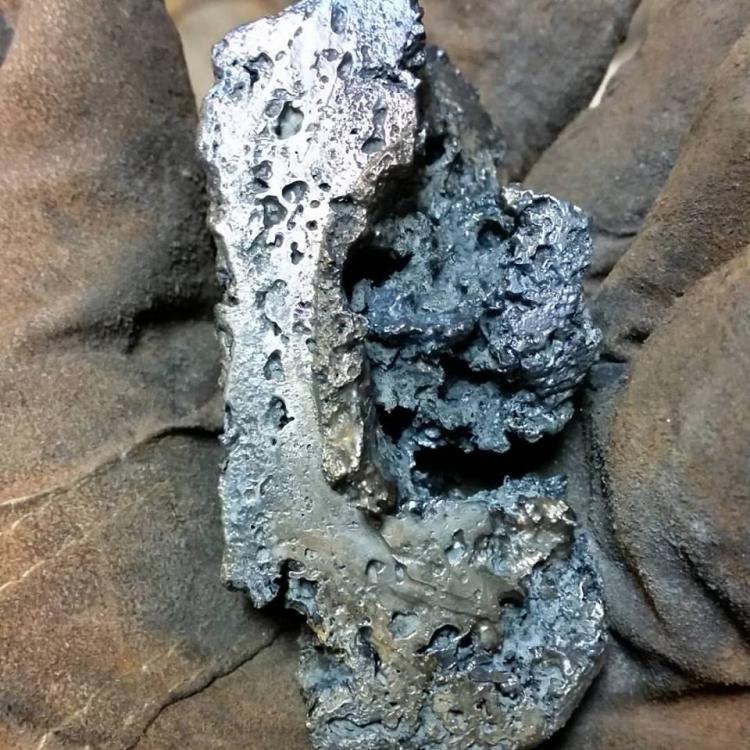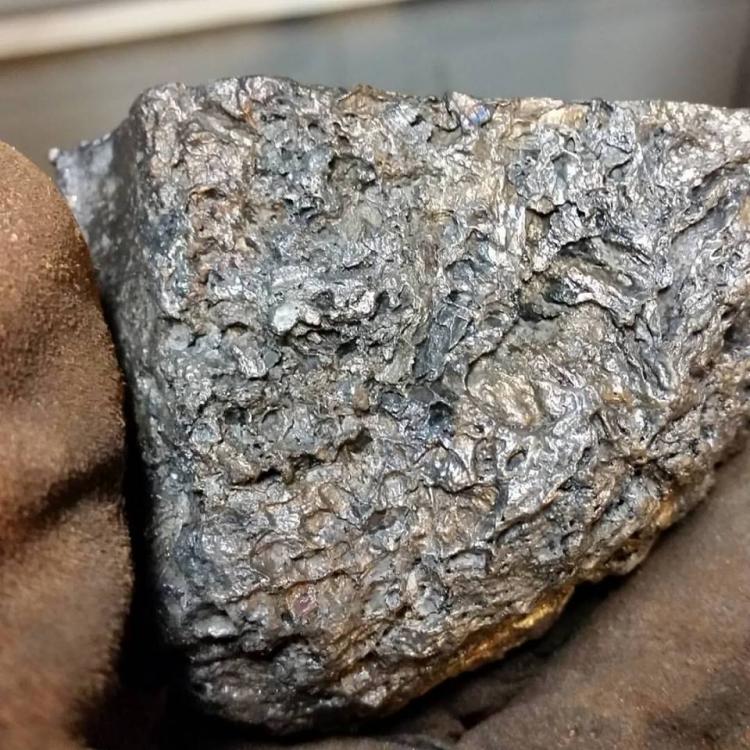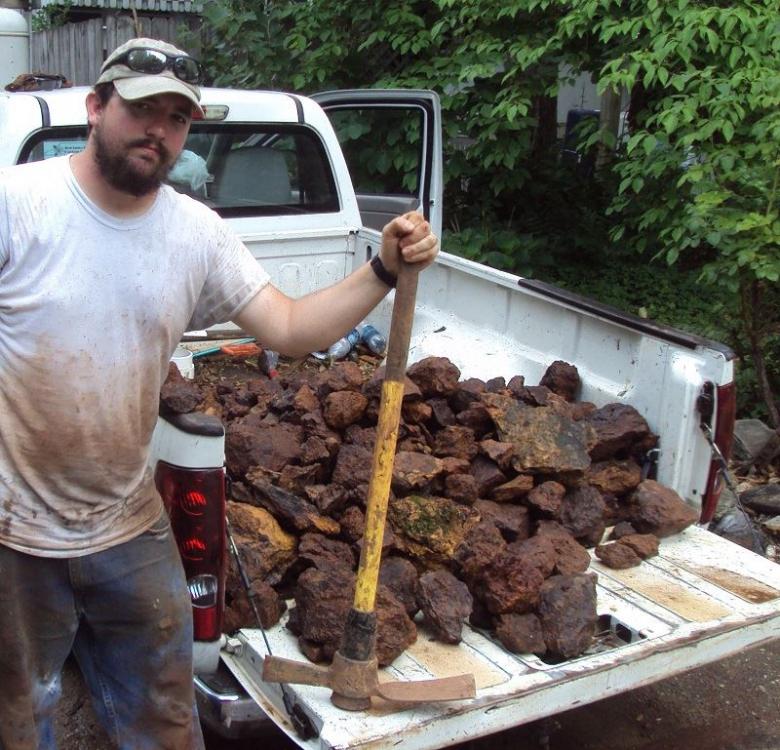-
Posts
664 -
Joined
-
Last visited
Content Type
Profiles
Forums
Articles
Gallery
Downloads
Events
Everything posted by DanielC
-
Shooting for a Waki, but it may be a tanto when it is all said and done. Started with nearly 3 pounds of material for this. This video shows the initial start to the first fold. Hit fold 6 today, and will do another 6 another day. I could have got more in today, but a good part of it was prep for this. Had to create my own clay slurry for one. Also had to refine my flux recipe. All went well.
-
Steel usually yields less than iron in hearth refining. If I start with 2 pounds of material I end up with 1.2-1.4 pounds of steel. Also the puddle was left alone with each piece. The slag seem to find their way to the bottom without trouble. I have also checked the pcb's (slags) for magnetism, and they have been devoid of iron material. The steel literally sits on top of the slag and all I have to do is lift up on the steel and it dislodges from the slag. So far I have received what I wanted. Clean steel with a carbon content above 1%, and still very forgeable. I'm thinking anywhere between 1-1.2% C
-
This is a cool event coming up. One day will be spent going to some ore spots in the area in Alabama. Most likely a hematite variety. The next day will be the smelting of the ore, and then forging the bloom for class participants. I will be here assisting Mark. I know it said the class was full, but I think the number was skewed since a few of us going clicked going, but are part of the instructional part. Hope a few can get a spot and go from here!
-

Hardening 4140 for Tenon work
DanielC replied to Burnttoast's topic in Heat Treating, general discussion
Soft as can be I say. I would rather mar up something like that, than my dies. -
Just an update. Took a break off of the project to finish other things. Bought an endmill to quickly finished the swoops that appear at the top of the dovetail, as all we had was a tiny one and it took forever. This new one shiuld get it in a single pass. Also bought another 5gal of Parks 50, upping my volume to 10 gallons of parks. Which the big block weighs 12# currently. I'm hoping that us closer to 10 once the dovetails are cut. I'm sure a half pound over isn't going to noticeably effect much. I am pretty set on a fast oil instead of water for this large cross section. I tested 3.5# 4140 hammers in my sword kiln recently and they turned out great. It will easily handle these.
-
Thanks guys. This I call a Japanese style, because it is what I prefer. Cutler hammer, weight forward, and maybe even doghead given the taper of both the steel and curve of the handle. The entire thing feels very natural. So much so that I have made myself several sizes to use.
-
-

moloch 50# hammer, what to look for
DanielC replied to JMarsh's topic in Power Hammers, Treadle Hammers, Olivers
That is a quality hammer. Very similar to my Murray, except mine was made in the motor driven era rather than the lineshaft. -

Small batches of magnetite ore?
DanielC replied to TimeToWaste's topic in Smelting, Melting, Foundry, and Casting
Of course. Join on in. -

Small batches of magnetite ore?
DanielC replied to TimeToWaste's topic in Smelting, Melting, Foundry, and Casting
Np. What is your name? A lot of people have been denied lately due to spamming potential. Need to make sure you make it through. -

Small batches of magnetite ore?
DanielC replied to TimeToWaste's topic in Smelting, Melting, Foundry, and Casting
Owen is right. The smelters group is ran by my friend Mark, one of the smelting wizards of the US. Basically all if the smelting wizards view or respond there, and probably more there than any where you will see online. -

Small batches of magnetite ore?
DanielC replied to TimeToWaste's topic in Smelting, Melting, Foundry, and Casting
We have a friend at a University that does it for us. As far as how and what he uses, I do not know. I don't give it out because it is a favor from him and I wouldn't want to bombard him. I could ask what they use though. -

Small batches of magnetite ore?
DanielC replied to TimeToWaste's topic in Smelting, Melting, Foundry, and Casting
Ti in our magnetite in our experience forces us to run our smelts hotter and slightly faster in result to fully liquify the slag. High amount of Ti are found in the black sands in Japan as well, and they too have to work their smelters accordingly. -

Small batches of magnetite ore?
DanielC replied to TimeToWaste's topic in Smelting, Melting, Foundry, and Casting
Other than analysis, is smelting. There isn't any visual ques that I can ascertain. Infact in the past what we though were the best rocks in our strata turned out to be not so much after analysis. Our best Fe content came from a mixture of several with an Fe content above 84%, with limonite. An example of our mixture can be shown below in analysis. -

Small batches of magnetite ore?
DanielC replied to TimeToWaste's topic in Smelting, Melting, Foundry, and Casting
Sort of off topic but I don't feel like making a whole thread for it. This is a small chunk of bloom steel recently made that I threw in an electrolysis bath. I thought it was rather beautiful -

Small batches of magnetite ore?
DanielC replied to TimeToWaste's topic in Smelting, Melting, Foundry, and Casting
When dealing with rocks, also keep in mind that a good rule of thumb is, it's usually not worth smelting I'd it contains less than 50% iron content - for the most part. -

Small batches of magnetite ore?
DanielC replied to TimeToWaste's topic in Smelting, Melting, Foundry, and Casting
I'm not saying don't do it. Just expect a lot of head scratching at first -

Small batches of magnetite ore?
DanielC replied to TimeToWaste's topic in Smelting, Melting, Foundry, and Casting
Well honestly, I havent noticed a considerably better quality bloom from magnetite than from limonite. Magnetite wants to turn into steel more readily than limonite in our experience, but it has to be ran differently. For instance, we find magnetite in the raw form, before it is eroded into rivers. Some of our magnetite has had Ti in it just like the japanese deal with in their ores. Some have Al in concentrations up to 20%, and since Al doesn't alloy, it is luckily bled off in the slag, though must be ran hotter than runs of say limonite to get that Al bearing slag juicy. A lot of what we do is built upon several years and over 100 smelts of research. To put it in perspective. An average size smelt to obtain a 10-15# bloom can easily consume around 150# of charcoal, and depending on the ore, 50#+ of that. Few people have a real successful smelt on their own on their first try. So that initial investment of charcoal, clays, air supply set up, and time could all be chalked up for a learning experience. Then say you tweak this or that for the next smelt, and the next is more successful than the last, and this repeats until you have a working stack and method. By the time you reached this point, you could have easily spent $1000, and probably more. Just a few things to consider. I have seen magnetite sold on ebay, along with red iron oxide. Limonite is all over the US though. Check mining charts in your area, and prepare to go hunting for rocks in the woods. Google maps is your friend. -
Alright, so today we only had a little bit of time to get things set up for another day. Basically milled off one of the sides (End of the die, not where we milled before) of the die that weren't exact from the steel supplier (Cut with a bandsaw), to get a good edge. Used indicators to get it all set-up. Going to raise the die by 1/32" at the 3" long (Our of 4" long) mark, and clamping it down. Will check over and over until we feel it is all true and cut in the last taper on this die. Will eventually get to the face of the die. This was but a minor hiccup. I usually always get something right eventually. My brother is a racecar engine machinist, and has a lot of nice little tools and gadgets to get what we need done, correctly. Of course, this is his first dovetail he has had to mess with, and going off of some of my direction, such as the omission of this 2nd taper. *shrug*
-

Small batches of magnetite ore?
DanielC replied to TimeToWaste's topic in Smelting, Melting, Foundry, and Casting
Some pics I found of our past exploits. The first pic is our last haul we made in a day, near a half ton. -

Small batches of magnetite ore?
DanielC replied to TimeToWaste's topic in Smelting, Melting, Foundry, and Casting
It's kind of an art. Though I would start where you are almost sure there would have been foot traffic and ore. I have seen a variety of limonite ranging from a deep red, to black, to various different veins of ocre. Moss loves to grow on the iron rich rocks, as do trees. We are lucky enough to have piles that were already pulled from various shafts on top of the foothill above the ancient smelter, and deposited in front of it. Tonnage worth. We found some of the best rocks with small trees growing on them. Just knock em over and with a pick axe, uproot rocks that haven't seen light in over a century. If you are lucky enough to have the labor of others mine it out for you, you are golden. If not, you have to follow the iron rich veins and break it out if the ground yourself. I have seen various strata in the 10' deep trenches the slaves during that time had carved into the hill. We have sent about 30 samples of ore off to be tested. Other than testing it out and smelting it, that is the most difinitive way to tell. I'll take photos of some of my various limonite types we have unearthed. It may help ad a reference point. -

Small batches of magnetite ore?
DanielC replied to TimeToWaste's topic in Smelting, Melting, Foundry, and Casting
One if my main questions is, why magnetite? Personally I feel magnetite would be a much harder first smelt than something like limonite. Magnetite ores, especially from river beds seems to be mostly devoid of a substantial amount of slag to assist in maintaining furnace heat, and protecting the bloom from decarb. We still magnetically clean our magnetite, but we also regulate the rate of drop as well with a binder. Magnetite also does not need to be roasted. There is a lot of information out there if you know how to find it. Which really is half the battle. Literature can only get you so far since parameters vary by so much that you simply cannot write a how-to book and expect everyone who follows it like a recipe to get similar results. Ore at your feet can be compositionally different than 10 feet away. One stack design can work greatly different than another. I have the biggest collection of smelting videos (from our adventures) available on the internet. Feel free to browse. https://www.youtube.com/user/TAGMushy/videos

